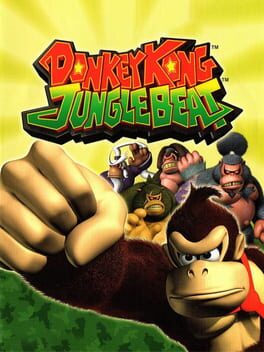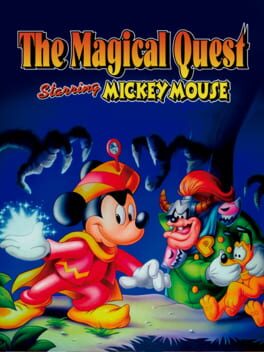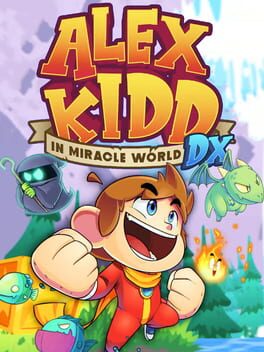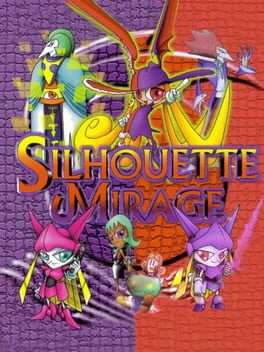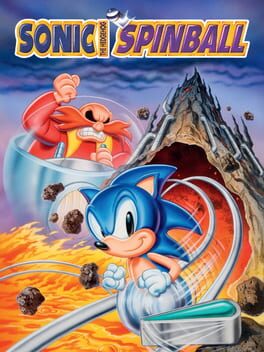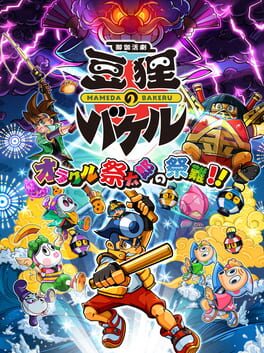WaffulSyrup
86 reviews liked by WaffulSyrup
Nintendo's last true arcade title. Not like, literally a game made for arcades, but in terms of design. It's no secret that I basically don't like anything Nintendo has put out in almost 20 years at this point. The easiest answer for why is that their new titles are very safe, chaste, inbred games with few new ideas. This isn't to say their new stuff is strictly bad, far from it. There's still a competency somewhere there. It's kind of like the best playing garbage ever though. What defines modern Nintendo games is mainly the lack of any sort of design that approximates 'something.' What I mean is that it's all self-referential to what 'games' collectively are, and what Nintendo games used to be, rather than just simply being fun games with an identity that isn't so tautological. I ponder over this because DKJB has a lot of those 'square-hole' style ideas that went on to plague more modern entries; Being a sort of precursor to Mario Galaxy, by staff and design motivations. Yet this is one of the only modern Nintendo games where the design isn't frustratingly patronizing.
Arcade game design had you fit very dense encounter variety back to back into your games. The nature necessitated it. Time was literally money, but it was also a good way of keeping a game fresh in the eyes of venue frequenters. There were all kinds of flashy games, which due to primitive tech, had to come up with unique ways of executing a usually simple idea. Back then, there weren't many standards in place, so a game more naturally became what it wanted to be. Putting it super succinctly so we aren't here all day: Back then arcade games were inherently more engaging because the concept had to be front and center, and that 'flashiness' was delivered through gameplay density. Donkey Kong Jungle Beat is a sidescrolling score attack game with a lot of ideas. From callbacks to the original Donkey Kong game with the logo font; To the barrel graze jingle, this game's explicitly introspective on the nature of arcade games. I see that even in how it controls. Just 3 inputs, Left, Right, and the 'Clap', which can be triggered by tapping the side of the bongos too. The somatosensory element of the controls are complemented by the frantic nature of the game as well. It can be very difficult to keep most combos going, and when DK grabs hold of enemies he beats the ever living daylights out of them. I'm pretty sure it was so violent it forced the ESRB to make E10+ because they didn't want this game to be rated T.
There's even an arcade game it actually closely resembles, in spirit and operation. Mach Breakers: Numan Athletics 2. A game about a superhuman decathlon. Mach Breakers also only has 3 inputs, insane mashing that really makes you FEEL the action of your characters, and above all extremely arcadey. I draw this comparison because there's even more DKJB could be paying homage to, that I may not be fully aware of because it's not exclusionary in that way. It's not some reference that exists solely for it's own value. It's kind of a more natural one, that I'm sure began during development as a coincidence and then they leaned into it as a genuine inspiration. I haven't even gone into the scoring system yet, which I find very interesting and well designed. Everytime DK does a unique action, such as backflipping, wall jumping, swinging, sliding up onto a ledge, etc; It adds to a combo trick meter. The combo stays going as long as you're in the air, unless you get hit. The combo counter acts as a multiplier for each individual instance of a banana you collect. Which bunches being their own multiple of 3. Additionally, when you grab many stray bananas at the same time using the clap motion it adds an additional amount by 1 per banana you caught. There's a lot they do with this. With all the unique enemy and banana layouts, it adds a lot of strategy to routing particular areas, without turning it into a chore necessarily. Because there's a lot of freeform stuff you can just try and do in the moment.
Not a whole lot of the game is up to scripted events. Even though you'd think there'd be a reason to add many of them because of the game's limited controls, the game uses them sparingly. Even when you grab a melon that was thrown at you as a projectile, there's still a chance it can miss when hit back because of poor positioning. But like, also, it has physics that do matter when being juggled by the claps soundwave. The game plays out mostly setpiece to setpiece, and the 'breaks' are still fraught with heavy mashing. It's a very involved game, but I love it for that.
Gotta say, I was quite welcomed with this remake, turning a catastrophe of a game, into something that's quite enjoyable to play.
visually and music are spectacular, a pretty game through and through, and controls have definitely been refined to help counter the poor level design that the original game had. with new levels, revamped bosses, and some quality of life bits like infinite lives and quicker progression.
This is one hell of a glowup to the og, and I'm just astonished.
visually and music are spectacular, a pretty game through and through, and controls have definitely been refined to help counter the poor level design that the original game had. with new levels, revamped bosses, and some quality of life bits like infinite lives and quicker progression.
This is one hell of a glowup to the og, and I'm just astonished.
Silhouette Mirage
1997
I have like, at least 100k characters at minimum at the ready everytime to explain why I love this game; But I'll just explain it very succinctly here.
Treasure's games are designed with a 'Turing-completeness' to their greater design space. A term coined by John Carmack when describing Doom, it is essentially a game that presents infinite possibilities. The producer and creator of this game, Kafuichi went on record stating he wanted to make an action game that wasn't strictly memorizable. And even though the combat is very unbalanced, the boss AI generally being easy to throw loop, he really did succeed. Even though the game's relatively easy, any challenge the game throws at you posits some of the most emergent gameplay I've ever seen.
The attribute mechanic is very introspective and just, COOL. I love how the zero teleport analog in this game can launch enemies, at a perfect angle where they'll get subsequently juggled, and you can grab them out of mid air and pole vault off of them or use their bodies as bullet soaking shields. Everything Shyna can do in this game is additive to it's core conceit. The difficulty might be a bit lopsided to some, the last few bosses being very particular. It kind of reminds me of Cave Story, how the bloodstained sanctuary tests muscles the game didn't build, because nothing else is quite like it. I still love this game to death. It's easily the coolest game ever created.
Treasure's games are designed with a 'Turing-completeness' to their greater design space. A term coined by John Carmack when describing Doom, it is essentially a game that presents infinite possibilities. The producer and creator of this game, Kafuichi went on record stating he wanted to make an action game that wasn't strictly memorizable. And even though the combat is very unbalanced, the boss AI generally being easy to throw loop, he really did succeed. Even though the game's relatively easy, any challenge the game throws at you posits some of the most emergent gameplay I've ever seen.
The attribute mechanic is very introspective and just, COOL. I love how the zero teleport analog in this game can launch enemies, at a perfect angle where they'll get subsequently juggled, and you can grab them out of mid air and pole vault off of them or use their bodies as bullet soaking shields. Everything Shyna can do in this game is additive to it's core conceit. The difficulty might be a bit lopsided to some, the last few bosses being very particular. It kind of reminds me of Cave Story, how the bloodstained sanctuary tests muscles the game didn't build, because nothing else is quite like it. I still love this game to death. It's easily the coolest game ever created.
Sonic Spinball is a fun idea in concept, but in execution it's frustrating beyond belief. Collecting emeralds in this game is almost puzzle-esque, but Sonic's terrible physics get in the way of any potential fun to be had figuring out how these levels work. Game's way too punishing as well, one slip-up can send you back to the start of the stage. Not too fun, but not the worst.
An incredibly good platformer that needed some extra time in the oven.
The gameplay fundamentals of this game are some of the most enjoyable I've seen from a platformer in a long time - it's all about learning how to optimize your movement and getting a feel for the controls. Save for some minor grievances with control feel and wishing there was a bit more variety with level structure and bosses, the main thing that I feel could dock this game some points for people is the lack of polish. There are a few bugs that can lead to death, which I can see frustrating people. They didn't bother me too much, but I'd hate for a very fun game's reputation to be soured by something like this when it's overall quite good.
The gameplay fundamentals of this game are some of the most enjoyable I've seen from a platformer in a long time - it's all about learning how to optimize your movement and getting a feel for the controls. Save for some minor grievances with control feel and wishing there was a bit more variety with level structure and bosses, the main thing that I feel could dock this game some points for people is the lack of polish. There are a few bugs that can lead to death, which I can see frustrating people. They didn't bother me too much, but I'd hate for a very fun game's reputation to be soured by something like this when it's overall quite good.
I adore this. Everything is lively and colorful, there were so many times where I'd stop progressing through a level to take it all in.
Speaking of levels there's a lot more than I thought there'd be, but the different gameplay styles really help keep things fresh! It's an easy game but I didn't mind at all. Plus I feel like those hidden tanukis you find in certain levels sorta made up for it, most of them were tricky to find!
I also love the way levels are completed in this game. Switching between the L and R buttons to use your drumsticks to restore the calamity towers and hearing that little jingle at the end never got old and always brought a smile to my face. One of my only gripes are the occasional framedrops. It can chug when there's a lot on screen, but other than that this is fantastic.
I played this with the english fan translation patch which was nice to have. Manifesting a localization announcement during the Nintendo Partner Showcase tomorrow because more people should check this out!
EDIT: Looks like it wasn't there... maybe next time Bakerubros
Speaking of levels there's a lot more than I thought there'd be, but the different gameplay styles really help keep things fresh! It's an easy game but I didn't mind at all. Plus I feel like those hidden tanukis you find in certain levels sorta made up for it, most of them were tricky to find!
I also love the way levels are completed in this game. Switching between the L and R buttons to use your drumsticks to restore the calamity towers and hearing that little jingle at the end never got old and always brought a smile to my face. One of my only gripes are the occasional framedrops. It can chug when there's a lot on screen, but other than that this is fantastic.
I played this with the english fan translation patch which was nice to have. Manifesting a localization announcement during the Nintendo Partner Showcase tomorrow because more people should check this out!
EDIT: Looks like it wasn't there... maybe next time Bakerubros
A very, very good update to an already great puzzle platformer. This version does have some problems though. The hurtboxes for Shy Guys seem to be a bit messed up - it's not uncommon to jump onto one and somehow die - and this is especially prominent in the new icy world.
Speaking of: the new levels are so much worse than the others in the game. They have neat ideas but they are not executed well at all. The main reason is that the ice physics (and particularly Mario's weird spin jump) don't feel like they were properly thought out. They might work well like this in a 2D platformer but these levels are usually barely larger than a single screen; the DK boss fight using this gimmick makes it especially apparent how much of an issue this weird skating jump doesn't fit into the slower, more-methodical movement system of the rest of the game.
It's a stark reminder how Nintendo Software Technology hasn't been allowed to make a new game in over a decade besides the other Mario vs. Donkey Kong games that nobody cared about and some crossword things on the 3DS. Hopefully they'll be allowed to make new games at some point again.
Speaking of: the new levels are so much worse than the others in the game. They have neat ideas but they are not executed well at all. The main reason is that the ice physics (and particularly Mario's weird spin jump) don't feel like they were properly thought out. They might work well like this in a 2D platformer but these levels are usually barely larger than a single screen; the DK boss fight using this gimmick makes it especially apparent how much of an issue this weird skating jump doesn't fit into the slower, more-methodical movement system of the rest of the game.
It's a stark reminder how Nintendo Software Technology hasn't been allowed to make a new game in over a decade besides the other Mario vs. Donkey Kong games that nobody cared about and some crossword things on the 3DS. Hopefully they'll be allowed to make new games at some point again.
Balan Wonderworld
2021
I haven't dropped a game in a long time. Balan Wonderworld changed that.
As a longtime fan of Sonic Team's work, I was absolutely stoked to hear that Sonic series creators Yuji Naka and Naoto Oshima were returning to collaborate again after years of separation. That optimism turned to skepticism the moment I saw this game in motion, and skepticism to disappointment when the reviews started rolling in. This game quickly became the biggest joke on the block, and after all this time I wondered, "could it truly have been that bad?" After all, I still enjoyed many of Naka's other projects despite their shortcomings. I decided to give Balan Wonderworld an honest shot. Big mistake.
This game forgoes so many 3D platformer game design hallmarks and traditions to the point where I have to wonder if the team persued feedback on certain things. The first and possibly largest offense - mapping everything to one button. Everything. Jumping, attacking, menu navigation - every button does the same thing, even the triggers. This proves to be incredibly tedious and frustrating as time goes on.
The second worst thing this game does just so happens to be its central mechanic, the outfit/powerup system. Powerups are incredibly situational and specific, and there are far too many for the game's own good. Half of them could have been meshed into singular, more versatile powerups - not only to mitigate the tedium of using them, but to lend themselves to more interesting stage mechanics and puzzles. Combine their one-note gimmicky nature with the fact that every button has one function, and that's where this game's faults peek through in plain sight. Have a powerup that focuses on attack? You can no longer jump until you find a powerup that allows for it.
Balan also likes to hide its secrets behind these powerups. Stages often hide their collectibles in plain sight, but require the use of an ability that you haven't encountered yet. This makes completing stages nigh unbearable. Other games hide their secrets similarly, but newfound abilities are typically integrated of into player's move set. Balan decides to take a decidedly more complicated approach, requiring the use of a changing room to swap outfits. On paper this isn't too bad an idea - but the fact that outfits are based on stock and must be individually collected from other stages is where Balan's progression becomes a lot more grating.
Music and visuals are nothing to write home about at all. Stage themes are uninteresting and cluttered, the general visual style is flat and uninteresting, and every tune went in one ear and out the other. Sadly ironic, considering that music and visuals were consistently some of the best parts of Naka and Oshima's previous works. The character designs are a treat to look at, but without appealing environments to stage them in I just find myself wishing they were in a better game.
All in all, this game drained me like few things have before and I only managed to get halfway. I need a palette cleanser. Time to start Spyro 2.
As a longtime fan of Sonic Team's work, I was absolutely stoked to hear that Sonic series creators Yuji Naka and Naoto Oshima were returning to collaborate again after years of separation. That optimism turned to skepticism the moment I saw this game in motion, and skepticism to disappointment when the reviews started rolling in. This game quickly became the biggest joke on the block, and after all this time I wondered, "could it truly have been that bad?" After all, I still enjoyed many of Naka's other projects despite their shortcomings. I decided to give Balan Wonderworld an honest shot. Big mistake.
This game forgoes so many 3D platformer game design hallmarks and traditions to the point where I have to wonder if the team persued feedback on certain things. The first and possibly largest offense - mapping everything to one button. Everything. Jumping, attacking, menu navigation - every button does the same thing, even the triggers. This proves to be incredibly tedious and frustrating as time goes on.
The second worst thing this game does just so happens to be its central mechanic, the outfit/powerup system. Powerups are incredibly situational and specific, and there are far too many for the game's own good. Half of them could have been meshed into singular, more versatile powerups - not only to mitigate the tedium of using them, but to lend themselves to more interesting stage mechanics and puzzles. Combine their one-note gimmicky nature with the fact that every button has one function, and that's where this game's faults peek through in plain sight. Have a powerup that focuses on attack? You can no longer jump until you find a powerup that allows for it.
Balan also likes to hide its secrets behind these powerups. Stages often hide their collectibles in plain sight, but require the use of an ability that you haven't encountered yet. This makes completing stages nigh unbearable. Other games hide their secrets similarly, but newfound abilities are typically integrated of into player's move set. Balan decides to take a decidedly more complicated approach, requiring the use of a changing room to swap outfits. On paper this isn't too bad an idea - but the fact that outfits are based on stock and must be individually collected from other stages is where Balan's progression becomes a lot more grating.
Music and visuals are nothing to write home about at all. Stage themes are uninteresting and cluttered, the general visual style is flat and uninteresting, and every tune went in one ear and out the other. Sadly ironic, considering that music and visuals were consistently some of the best parts of Naka and Oshima's previous works. The character designs are a treat to look at, but without appealing environments to stage them in I just find myself wishing they were in a better game.
All in all, this game drained me like few things have before and I only managed to get halfway. I need a palette cleanser. Time to start Spyro 2.
